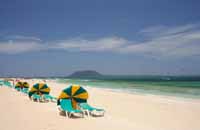The second largest of the Spanish Canary Islands, Fuerteventura is located to the south-west of Lanzarote, off the coast of north-west Africa, it has an are of 1,660 square kilometres and a resident population of around 74,983, over one third of whom live in the capital Puerto del Rosario. Fuerteventura has some of the best beaches in the entire Canary Islands group and has areas of sand dunes similar to those found around Maspalomas in Gran Canaria. Not quite as well known as a holiday destination, Fuerteventura still attracts thousands of holidaymakers each year, they arrive to enjoy the sunny weather and most are looking for a beach style holiday but without the crowds of Lanzarote, Tenerife or Gran Canaria. Not yet developed to the extent of neighbouring islands, Fuerteventura only has a few resorts of any note, the main one being Corralejo, while others exist at Jandia and Caleta de Fuste. The island can be easily reached by air (the airport is near to Puerto del Rosario) or by ferry from Lanzarote and Gran Canaria.
September 21, 2010
April 6, 2010
Corralejo Fuerteventura
The best known and largest of Fuerteventura’s resorts, Corralejo is situated on the northernmost tip of the island, the least populated of the main Canary Islands off the coast of North West Africa. This former fishing village has developed into a considerable holiday resort offering the main requirements needed for the typical package beach style holiday in the shape of sandy beaches, sunny weather, quality hotels and good facilities. Fuerteventura and Corralejo in particular certainly has beaches and these stretch for many miles in each direction and include a huge area of sand dunes which now form a Natural Park. The superb weather conditions allow visitors to travel here right through the year, with plenty of sunshine whatever month you arrive. From the main beach you can look across the turquoise blue ocean to the neighbouring island of Los Lobos another Natural Park which you can also visit. The best way to arrive in Corralejo, Fuerteventura is by way of the ferry from Playa Blanca on the island of Lanzarote, but you could also fly into the airport at Puerto del Rosario, Fuerteventura’s capital.
November 6, 2009
Playa de Papagayo Lanzarote
Boasting some of the finest beaches on the Canary Island of Lanzarote, Punta de Papagayo is a breezy point at the southerly end of the island. Somewhat isolated and not yet developed the area still attracts lots of tourists, seeking quieter beaches away from the busy resorts. The main and most popular of the beaches, Playa de Papagayo is easily accessed by road from nearby Playa Blanca, some of the other beaches are easier to reach by walking or by boat. There are regular boat trips operating from the harbour in Playa Blanca, and many choose this method as a more exciting way to visit. All the beaches benefit from superb views to the nearby island of Fuerteventura, and all are worth a visit if you are travelling around Lanzarote this year. Playa de Papagayo Map.
September 1, 2009
Canary Islands the Early Years
One of the most popular winter holiday destinations for Europeans seeking some off peak sunshine is the Spanish Canary Islands, an archipelago of islands and islets located off the north-east coast of Africa. The Canary Islands have a long and interesting past and Canary Islands history is fascinating to discover. First settled some 5,000 years ago the earliest true civilisation occurred during the second century BC when a tribal culture known as the Guanches lived in caves and built primitive villages. The Guanches were still in occupation when the Romans arrived in 40 BC, as Juba II explored the region which was then called the Fortunate Islands. The present name was probably derived from the breed of dogs which lived on the islands and met the Roman explorers, they were large and fierce and no doubt left an impression on the arrivals. The islands, to all intents and purposes, disappeared from the map for over 1,000 years after the fall of the Roman Empire and were not set foot on again until the beginning of the 14th century when a Genoese captain called Lazarotto Malocello bumped into the island later named after him (Lanzarote) and took the news of its existence back to Europe. Later expeditions led to the eventual invasion by a small force under Jean de Bethencourt, he landed on Lanzarote and built a fort on Fuerteventura before running out of provisions and heading for the Spanish mainland to muster additional support from the Castillians.
